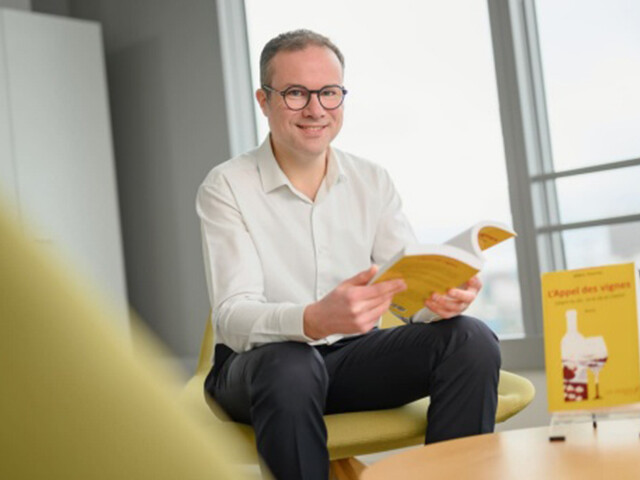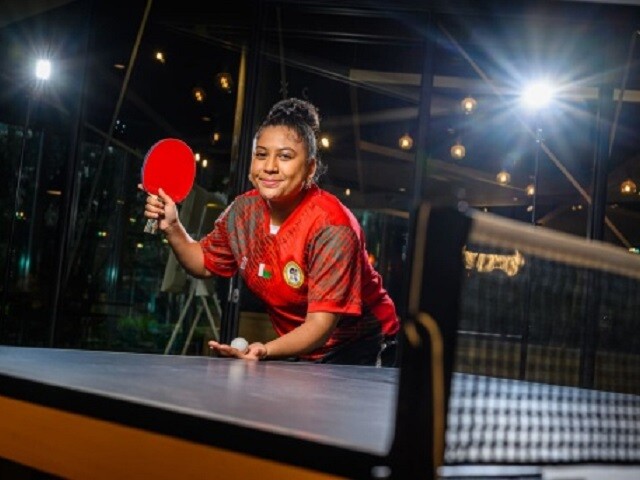Trump cards and strong dots
What are your educational and career paths?
Annaïg Della Monta: Following my “Bac S” high school diploma and a preparatory science course, I studied process engineering in Grenoble. I first joined Kimberly Clark in 2000, the makers of Kleenex tissue. After working in production at three sites in France and the UK for 18 months, I was transferred to Germany where I was responsible for a feminine hygiene product range in particular. I was offered to relocate when the plant regrettably shut down, but I was enjoying living in Germany. So I decided to shift my career towards the business side, and in 2006 joined Huhtamäki, who were one of my suppliers, as Head of Key Accounts for hygiene and construction films. After my first child was born, I joined Amcor in 2009, a global packaging group. In this job, I was in charge of developing industrial customers and business at European level. I then had my second child. This gave me time to think about where to take my career next. Arkema ticked all the boxes. I joined the Group in 2013, first as Sales Manager for the Sartomer subsidiary in southern Germany, before moving on to Bostik in 2018 as European Business Development Manager for Engineering Adhesives. Bostik had decided to enter this market. We were starting virtually from a clean sheet. We had to build up an entire business, a new range, and a strategy. Being at the outset of an adventure like that is a fantastic opportunity to be able to grow with the project.
What is the underlining guideline of your extremely varied career path?
A. D. M.: Undoubtedly new challenges, a desire to forge ahead. When I chose Bostik, I was looking for a company with plenty of interesting things going on. Always with the idea of achieving the best possible balance between my professional and personal life. When I arrived in Germany 20 years ago, I liked it very much. Being from the Alsace region of France in the first place and then meeting my husband here probably played a part (she says with a smile). I live near Nuremberg. There is excellent quality of life, and I like the way of working of German people. A blend of rigor and efficiency with genuine respect for your professional life.
Tell us about your job. Who do you work with?
A. D. M.: I am in charge of the European-wide business development of Engineering Adhesives. It is a multi-faceted responsibility involving me from the development of products to their manufacture and marketing. I talk to various players, in R&D, or technical departments, marketing, sales, and, of course, to our customers. A key part of my job is to report their various inputs to help us develop the products that best meet their needs. I work with various R&D centers, in particular Bostik Smart Technology in Venette, France, as well as the Afinitica labs in Spain specializing in cyanoacrylates, the first product range we launched. I also provide support. For example, by organizing the training of the Bostik sales force as part of our Born2Bond™Academy. I then assist them when they have projects with their own customers. This wide-ranging management of projects is extremely interesting. And so is contact with international teams. Our work is very collaborative and complementary, and our roles are split between Asia, Europe, and the United States. I make sure that we are all working in unison.
What is Born2Bond™?
A. D. M.: At Engineering Adhesives, we offer a product portfolio based on various technologies to address top-of-the-range markets. With the Born2Bond™ range, we have an innovative range of fast-curing high performance bonding adhesives, launched in 2019. These are designed for “by-the-dot”, therefore ultra precise, applications in specialist sectors such as automotive, electronics, luxury goods, luxury packaging, medical devices, and MRO. All of which are fast-growing markets. Take your smartphone, your watch or the electric battery in your car, and you will undoubtedly find our Born2Bond™ products in there. In fact, we are always innovating. For example, by launching at the moment anaerobic adhesives whose function is to perfectly bridge the gaps between components, in order to improve the tight bond or the holding force of a mechanically fixed assembly.
This level of precision and demand can be found in your passion for the game of bridge. How did it come about?
A. D. M.: I learned to play in 1998 during my Erasmus year in England at Imperial College London. I became addicted to it in no time. I continued playing in Germany, raising my level to the point of winning three German championship titles in 2004, 2009 and 2015, and another in a mixed team in 2007. I also came 4th in the European Team Championship in 2010. Meanwhile, in 2008, I was lucky enough to take part in the first World Mind Sports Games in China. It was simply extraordinary to be in Beijing on the site of the Olympic Games! We lost in the quarter-finals against the Chinese team, but it remains one of my greatest memories.
An opportunity to be able to grow with the project.
What are the main principles of the game?
A. D. M.: First of all, to play bridge, you need 4 people and a deck of 52 cards. Ace, king, queen, jack and 10 are the honor cards. Each has a value: 4, 3, 2 and 1 points, or 40 points in total per deck. Players are designated by the cardinal points and paired: North plays with South against East and West. The teammates sit opposite each other. 13 cards are dealt to each player. The game consists in exchanging information with your partner, the “bids”, to reach a specific target. The players bid for the right to name the trump suit, or to play without, and they set the level of the final “contract” corresponding to a certain number of tricks. The player who declares the contract is called the “declarer”. The player sitting to his left plays the first card. Once this first card is played, the teammate of the “declarer” lays down his cards face up on the table. He becomes the “dummy”. He no longer plays his cards himself, but those shown to him by the “declarer”. Each player takes turn in throwing a card, and the player who has played the strongest of the 4 cards wins the trick. He starts the next trick. By the end of the game, 13 tricks have been played. The aim of the game is to win a number of tricks laid down at the time of the “auction”. There are seven contract stages to be completed. Each stage corresponds to a number of tricks to be achieved. For example, a bid has to be for 7 tricks minimum. If the team fulfills its contract, it is awarded points. If it fails, it is said to “fall”, and its opponents score the points. The ultimate goal of the game, to win a game, is to reach a certain number of points.
What qualities do you need to win a game of bridge?
A. D. M.: You just have to manage adding up a little (she says laughing)! There is a system of declarations to remember. Some are straightforward while others are more complicated. It all depends on the level you are playing at. If playing for fun, it’s all about the social dimension. For me, this is a very important part of bridge because sitting around a table with others is a great way to get together, chat, and have a good time. Then, the higher the level you play at, the more you have to rely on math and probability to find the best “contract” and score as many points as possible. I love this very strategic dimension. Not much is left to chance because all the players play the same hand (same cards). It is better to be competitive. This is something I also have in my job, the desire to perform, win contracts with customers and move the business forward. And in bridge as at work, it is important to form a good team and for the teammates to know each other well. The psychological aspect is very important in bridge, and if you are a strong team where everyone supports each other, you are more likely to give the best of yourself. Experience of the game also matters a lot. You have to be prepared. Playing five hours in a row is demanding.
Is the team always united?
A. D. M.: Some players are more extroverted. They need to express their feelings, say loud and clear “that was great”, or, on the contrary, “that was useless what you did”! Personally, I prefer to play with quiet teammates, who give me encouragement. It gives me the serenity and confidence I need. One thing is for sure, you can have two very good bridge players, if they do not get along, it is not going to work. That is kind of true with everything, isn't it?
When and how do tournaments take place?
A. D. M.: Tournaments are men only, women only or mixed. You also have championships. Depending on the format, it can be over a weekend, or span one or two weeks or even a year. I have a full-time job and a family with two children so I have to get organized. I sometimes take time off to play in a bridge championship!
Who is the bridge equivalent of Birgit Prinz, to name a great German female football player?
A. D. M.: You are referring to football, so, imagine that when I watch a game of bridge, for me it is like watching a football match on TV for other people. I get up from my chair when great tricks are played! Now, for a star of this game, I would say someone like Sabine Auken, who is regarded, with her teammate Daniela von Arnim, as one of the best players in the world. I had the chance to play as her teammate once. She has won every prize in the women’s game. Today she plays in the German “Open” team with the men. It must be said that men have long been considered the undisputed masters of the game, but in recent years, women's bridge has made enormous progress. British female players are obviously excellent at bridge. Britain is the country where the game appeared in 1885 in its current form. French female players are also very strong. French bridge is second in the world at competition level. The federation estimates that from one and a half million players in France, 55% are women.
Why, would you say, does bridge still has this elitist image?
A. D. M.: The drawback of bridge, but it's also what makes it a fascinating game, is that it takes time to take in the rules. You really have to put in the effort. There is also this cliché of the old English aristocracy playing bridge while sipping tea. It is true that it is not always easy to recruit young people. Paradoxically, the health crisis has helped acquaint people with it through online games. This is how both my children started to learn it. They seem to be up to it. It promises us great games. Meanwhile, bridge is at the top of my diary as I have just learned that our team will take part in the World Championship at the end of March. We came tenth in the European Championship last summer, two places from qualifying, but a team withdrawal gave us another chance!







